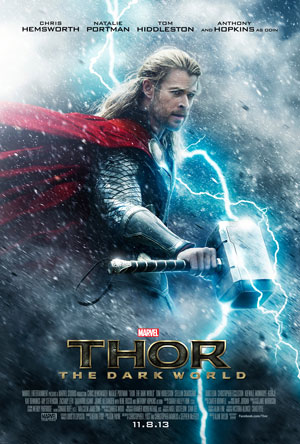As science and engineering majors, the release of new comic book based films are widely anticipated, yet at the same time will be dissected as Newton’s Laws are broken. The release of “Thor 2: The Dark World” was no different. One would think that in recent years, science consultants would be hired to verify that the science portrayed in film is both accurate and interesting. Film is a great way to communicate science to the public, so why not do it right? Yet Marvel apparently could not afford to consult a geophysicist in the making of Thor 2.
First of all, “The Dark World” is worth a watch. The film does not disappoint in the action department. And though another sequel, the plot remains interesting enough to not be too redundant while packing some humor into it. Thor (played by Chris Hemsworth) has to work with his criminal brother Loki (Tom Hiddleston) to save the entire universe from Dark Elves as the Nine Realms align.
This is where the bad science comes in. It seems that bad physics such as not conserving momentum has gotten too mainstream—Marvel instead brings in cool-sounding, more obscure science to butcher. This leaves the geoscientists to shudder and twitch as terms like “gravimetric anomalies” are thrown around. Jane Foster (Natalie Portman) is a scientist, and carries around a fancy meter that apparently takes gravity readings. The device alerts her when there is an anomaly, and in the film, the last time gravimetric anomalies of this nature were present was when Thor first came to Earth. Students who have taken GPGN303 – Gravity, Magnetic, and Electrical Methods know that even the most high-tech gravimeters are bulky and require a certain amount of data processing to detect gravity anomalies. So it is absurd that a device the size of a TI-84 Silver would be able to collect gravity data, make corrections (like height and surrounding regional density), and invert it to alert the user of a nearby anomaly.
Of course the question everyone is wondering is, “Why would Thor’s presence perturb the gravity field? What do the alignment of the Nine Realms have to do with gravity?”. In geophysics, gravity anomalies indicate varying material density in the subsurface, not the presence of cosmic gods. Jane Foster’s character is an astrophysicist; what is she even doing with this new-fangled gravimeter? Satisfaction of the film is gained only by suspension of disbelief here. After all, hammer-wielding Asgardians such as the mighty Thor exist, so why not have them able to create “gravimetric anomalies”?
For those who have gravity data processing near and dear to their heart, the inaccurate portrayal is a disgrace, but in that feeling, the point is missed. Marvel is actually trying to make science cool, and deserves a tip of the hat for that. In the comics, Jane Foster’s character is a nurse. Why make her an (inaccurately portrayed version of ) an astrophysicist? Because again, film has a broad voice, and this one takes a shot at putting not one, but two females in the roles of scientists, professions that are generally portrayed in popular culture as socially awkward males (think CBS’s “Big Bang Theory”). This is important because getting girls interested in science is important. Whether an astrophysicist or geophysicist, it does not matter: Jane Foster being a scientist is cool, and the young eyes watching “The Dark World” will start to think so too.
Marvel recently announced their partnership with National Academy of Science and Girl Scouts of America in creating a program that would spark girl’s further interest of different sciences. The program was actually a competition and is called “Thor: The Dark World Ultimate Mentor Adventure”. It encouraged high school girls to seek out and interview a mentor in science, engineering, technology, or math. The prizes included meeting with women senior scientists from Dolby Laboratories and being recognized at “The Dark World” premiere on November 8.
Programs like this are needed because more women in science who are role models are needed. The big screen might actually do a decent job of recruiting to the sciences. But those girls who were inspired to be an astrophysicist after watching “The Dark World” might need to change their major to geophysics once they realize they won’t be working on alien “gravimetric anomalies” as an astrophysicist. Hopefully Marvel decides to hire them after graduation to consult for whatever sequel movie they will be making.


'Why it is okay that Thor 2 has bad science' has no comments
Be the first to comment this post!